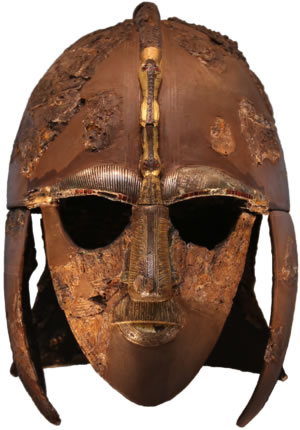 The Sutton Hoo helmet is a decorated Anglo-Saxon helmet which was discovered during the 1939 excavation of the Sutton Hoo ship-burial. It was buried around 625 and is widely believed to have been the helmet of King Raedwald of East Anglia, and its elaborate decoration may have given it a secondary function akin to a crown. The helmet is 'the most iconic object' from 'one of the most spectacular archaeological discoveries ever made,' and one of the most important Anglo-Saxon artefacts ever found. Its visage features eyebrows, nose, and moustache, creating the image of a man joined by a dragon's head to become a soaring dragon with outstretched wings. It has become a symbol of the Dark Ages and also 'of Archaeology in general.' It was excavated as hundreds of rusted fragments, and was first displayed following an initial reconstruction in 1945-46, and then in its present form after a second reconstruction in 1970-71.
The Sutton Hoo helmet is a decorated Anglo-Saxon helmet which was discovered during the 1939 excavation of the Sutton Hoo ship-burial. It was buried around 625 and is widely believed to have been the helmet of King Raedwald of East Anglia, and its elaborate decoration may have given it a secondary function akin to a crown. The helmet is 'the most iconic object' from 'one of the most spectacular archaeological discoveries ever made,' and one of the most important Anglo-Saxon artefacts ever found. Its visage features eyebrows, nose, and moustache, creating the image of a man joined by a dragon's head to become a soaring dragon with outstretched wings. It has become a symbol of the Dark Ages and also 'of Archaeology in general.' It was excavated as hundreds of rusted fragments, and was first displayed following an initial reconstruction in 1945-46, and then in its present form after a second reconstruction in 1970-71.
Cultural impact
A wicker copy of the helmet on display at the Museum of English Rural Life in Reading, Berkshire
The 1971 reconstruction of the Sutton Hoo helmet was widely celebrated, and in the five decades since it has come to symbolise the Middle Ages, archaeology, and England. It is depicted on the covers of novels, textbooks, and scholarly publications, such as The Winter King by Bernard Cornwell and The Anglo-Saxons by James Campbell, and has influenced artists, filmmakers and designers. At the same time, the helmet has become the face of a time once known as the Dark Ages, but now recognised for its sophistication in part because of the finds from Sutton Hoo and referred to as the Middle Ages. It gives truth to a period of time known from depictions of warriors and mead halls in Beowulf, once thought fanciful, and personifies the Anglo-Saxons in post-Roman Britain. Considered 'the most iconic object' from an archaeological find hailed as the 'British Tutankhamen,' in 2006 it was voted one of the 100 cultural icons of England alongside the Queen's head stamp, the double-decker bus, and the cup of tea.